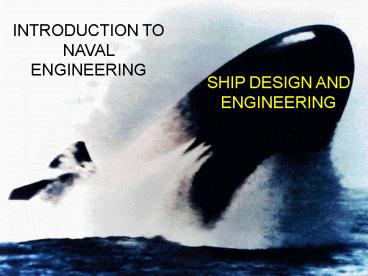ENGINEERING LESSON GUIDE 18 PowerPoint PPT Presentation
Title: ENGINEERING LESSON GUIDE 18
1
INTRODUCTION TO NAVAL ENGINEERING
SHIP DESIGN AND ENGINEERING
2
BASIC DESIGN CONSIDERATIONS
- Seaworthiness
- Ships ability to operate in all types of weather
and sea states - Made up of several factors
- Stability
- Displacement
- Freeboard
- Beam
- Hull shape
3
BASIC DESIGN CONSIDERATIONS (cont.)
- Structural Integrity
- Engineering design
- Weight
- Resistance to operational stresses and strains
4
BASIC DESIGN CONSIDERATIONS (cont.)
- Operational Employment
- Mission
- Armament
- Protection
- Maneuverability
- Cruising Range
5
BASIC DESIGN CONSIDERATIONS (cont.)
- Tradeoffs
- Cost
- Life expectancy
- Port facilities
- Prime mover machinery/engineering design
6
FORCES
7
STRESS
- Tension
- Compression
- Shear
- Torsion
8
STRAIN
- Distortion resulting from stress
- Usually expressed in inches/inch
9
SAGGING
- Deck under compression
- Neutral axis experiences no stresses
- Keel under tension
10
HOGGING
- Deck under tension
- Neutral axis experiences no stress
- Keel under compression
11
STRUCTURAL ELEMENTS OF A SHIP
12
Principle structural elements of a warship
- Plating
- Keel
- Bottom
- Framing
- Transverse frames
- Longitudinal frames
- Bulkheads
- Decks
13
COMPARTMENTAL NUMBERING SYSTEM
14
4 PARTS3 - 75 - 4 - M
- Deck
- Main deck is 1
- Up is O1, O2, etc
- Going down is 2, 3, etc
- Frame
- Frame number at the foremost bulkhead of the
enclosing boundary - If between frames, forward one is used
15
4 PARTS3 - 75 - 4 - M
- Compartment
- Centerline is 0
- Port are even
- Starboard are odd
- Use
- Capital letter designating use
- A Stowage L Living E Emergency
- G Gas M Ammo C Control
16
SUBMARINE CONSTRUCTION
17
Basic structural components of a submarine
- U.S. submarines employ a single hull design.
Advantages include - Larger interior volume
- Quieter
- Russian submarines employ a two-hull design.
Advantages include - Ease of fabrication
- Abilty to absorb damage
18
(No Transcript)
19
QUESTIONS?
20
Reading
- Introduction to Naval Engineering, Chapter 26
- Naval Orientation, pp. 17-9 - 17-12
- The Bluejackets Manual, Chapter 18
PowerShow.com is a leading presentation sharing website. It has millions of presentations already uploaded and available with 1,000s more being uploaded by its users every day. Whatever your area of interest, here you’ll be able to find and view presentations you’ll love and possibly download. And, best of all, it is completely free and easy to use.
You might even have a presentation you’d like to share with others. If so, just upload it to PowerShow.com. We’ll convert it to an HTML5 slideshow that includes all the media types you’ve already added: audio, video, music, pictures, animations and transition effects. Then you can share it with your target audience as well as PowerShow.com’s millions of monthly visitors. And, again, it’s all free.
About the Developers
PowerShow.com is brought to you by CrystalGraphics, the award-winning developer and market-leading publisher of rich-media enhancement products for presentations. Our product offerings include millions of PowerPoint templates, diagrams, animated 3D characters and more.

